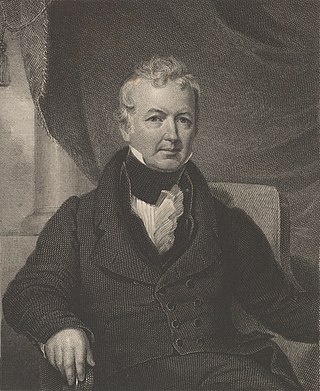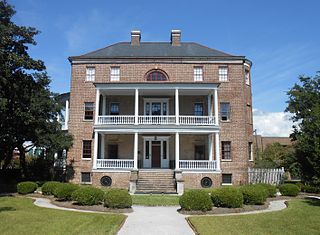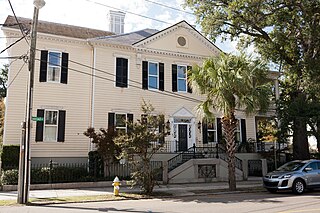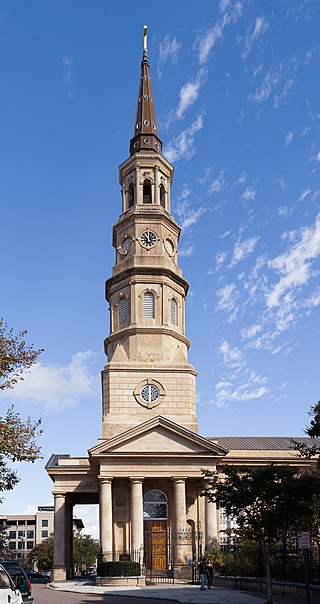
Georgetown is the third oldest city in the U.S. state of South Carolina and the county seat of Georgetown County, in the Lowcountry. As of the 2010 census it had a population of 9,163. Located on Winyah Bay at the confluence of the Black, Great Pee Dee, Waccamaw, and Sampit rivers, Georgetown is the second largest seaport in South Carolina, handling over 960,000 tons of materials a year, while Charleston is the largest.

Edward Rutledge was an American Founding Father and politician who signed the Continental Association and was the youngest signatory of the Declaration of Independence. He later served as the 39th governor of South Carolina.

Robert Barnwell Rhett was an American politician who served as a deputy from South Carolina to the Provisional Confederate States Congress from 1861 to 1862, a member of the US House of Representatives from South Carolina from 1837 to 1849, and US Senator from South Carolina from 1850 to 1852. As a staunch supporter of slavery and an early advocate of secession, he was a "Fire-Eater", nicknamed the "father of secession".

Joseph Hayne Rainey was an American politician. He was the first black person to serve in the United States House of Representatives and the second black person to serve in the United States Congress. His service included time as presiding officer of the House of Representatives.

Robert Smalls was an American politician, publisher, businessman and maritime pilot. Born into slavery in Beaufort, South Carolina, he freed himself, his crew and their families during the American Civil War by commandeering a Confederate transport ship, CSS Planter, in Charleston harbor, on May 13, 1862, and sailing it from the Confederate-controlled waters of the harbor to the U.S. blockade that surrounded it. He then piloted the ship to the Union-controlled enclave in Beaufort–Port Royal–Hilton Head area, where it became a Union warship. His example and persuasion helped convince President Abraham Lincoln to accept African-American soldiers into the Union Army.

William J. Gaston was a jurist and United States Representative from North Carolina. He was the author of the official state song of North Carolina, "The Old North State". Gaston County, North Carolina, created just after his death, was named for him, as later were the city of Gastonia, North Carolina, artificial Lake Gaston, and the Gaston Hall auditorium at his alma mater, Georgetown University.

In the law regulating historic districts in the United States, a contributing property or contributing resource is any building, object, or structure which adds to the historical integrity or architectural qualities that make the historic district significant. Government agencies, at the state, national, and local level in the United States, have differing definitions of what constitutes a contributing property but there are common characteristics. Local laws often regulate the changes that can be made to contributing structures within designated historic districts. The first local ordinances dealing with the alteration of buildings within historic districts was enacted in Charleston, South Carolina in 1931.

The Miles Brewton House is a National Historic Landmark residential complex located in Charleston, South Carolina. It is one of the finest examples of a double house in Charleston, designed on principles articulated by Andrea Palladio. Located on two acres, its extensive collection of dependencies makes it one of the most complete Georgian townhouse complexes in America. The house was built ca. 1765-1769 for Miles Brewton, a wealthy slave trader and planter.

Benjamin Franklin Whittemore, also known as B. F. Whittemore, was a minister, politician, and publisher in the United States. After his theological studies, he was a minister and then during the Civil War, a chaplain for Massachusetts regiments. Stationed in South Carolina at the end of the war, he accepted a position of superintendent of education for the Freedmen's Bureau. A Republican, he was elected a U.S. Representative from South Carolina. He was censured in 1870 for selling appointments to the United States Naval Academy and other military academies. He spent his later years in Massachusetts, where he was a publisher.

Arthur Middleton Manigault was a brigadier general in the Confederate States Army during the American Civil War.

Edward Brickell White, also known as E. B. White, was an architect in the United States. He was known for his Gothic Revival architecture and his use of Roman and Greek designs.

The Joseph Manigault House is a historic house museum in Charleston, South Carolina that is owned and operated by the Charleston Museum. Built in 1803, it was designed by Gabriel Manigault to be the home of his brother, and is nationally significant as a well-executed and preserved example of Adam style architecture. It was declared a National Historic Landmark in 1973.

The 1870 United States House of Representatives elections in South Carolina were held on November 1, 1870 to select six Representatives for two-year terms from the state of South Carolina. The fifth and sixth seats were decided by an at-large election, but the House of Representatives refused to seat the two winners. The two incumbents who ran were re-elected and the two open seats were retained by the Republicans. The composition of the state delegation thus remained solely Republican.

The Edward Rutledge House, also known as the Carter-May House and now The Governor's House Inn, is a historic house at 117 Broad Street in Charleston, South Carolina. This 18th-century house was the home of Founding Father Edward Rutledge (1749–1800), a signer of the United States Declaration of Independence and later Governor of South Carolina. Despite many changes to the house, it retains its 18th-century core dating to about 1760, and was declared a National Historic Landmark in 1971.

Gabriel Manigault was an American architect.

St. Philip's Church is an historic church at 142 Church Street in Charleston, South Carolina. Its National Historic Landmark description states: "Built in 1836, this stuccoed brick church features an imposing tower designed in the Wren-Gibbs tradition. Three Tuscan pedimented porticoes contribute to this design to make a building of the highest quality and sophistication." On November 7, 1973, it was added to the National Register of Historic Places and designated a National Historic Landmark.

Prince George Winyah Parish Church is an Anglican church in Georgetown, South Carolina. Prince George Winyah is one of the oldest continuous congregations in South Carolina, and the church building is one of the oldest churches in continuous service in South Carolina. Prince George Winyah (Anglican) and Churchyard was named to the National Register of Historic Places on May 6, 1971.

Peter Horry was an American planter who served as an officer in the southern theater of the American Revolutionary War. He served under the command of Francis Marion, waging a guerilla war against the British and Loyalist forces. Peter Horry was elected to public office, served in the state militia, and oversaw several plantations. He is the namesake of Horry County, South Carolina.
Rainey House may refer to:

James Alfred Bowley was an American teacher, lawyer, judge, school commissioner, politician, and newspaper publisher in South Carolina. He escaped slavery in Maryland with help from Harriet Tubman. He served in the U.S. Navy. After the American Civil War he moved to Georgetown, South Carolina, taught in schools and was elected to the South Carolina House of Representatives. His former home in Georgetown, where he lived with his wife Laura Clark (1854–1932), is a historic site.
























